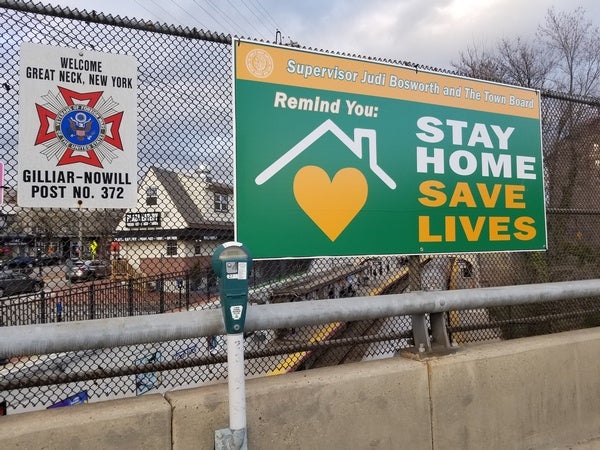
Right now, there’s an academic couple living in a fully stocked cabin house, drinking wine, teaching an online class they’ve taught before and reading their favorite books. They are cozy, generally enjoying social distancing.
In contrast, there are also poor, elderly, extroverted, and young Americans stuck in cities and rural locations lacking in resources. They are afraid and are generally having an extremely unpleasant experience with social distancing.
In short, people are experiencing different levels of “solution aversion” when it comes to the one-size-fits-all advice for staying safe from COVID-19. Solution version is the psychological phenomenon in which people tend to resist or deny the problem when they are averse to the solution.
Aaron Kay and I first published on this psychological effect in 2014 with a series of studies about how people with certain aversions denied problems (e.g, climate change, air pollution, gun violence) to a greater or lesser degree depending upon how we experimentally varied the aversiveness of various solutions.
With COVID-19, communicating the scientific fact that we need to maintain social distance is important, but it is not enough. We can’t just keep posting that one flatten-the-curve graph and expect people to change their behavior willingly. Showing them graphs hasn’t been enough with climate change, and it won’t be enough with COVID-19.
To help combat COVID-19 we need to understand the concept of solution aversion; understand why others may be experiencing solution aversions that we are not; and figure out ways to address people’s different aversions.
First, let us start with the most obvious example of differential solution aversion: the introvert versus the extrovert. An introvert might be tweeting gleefully, “This is what I have been preparing for my whole life!” and then proceeding to enjoy their solitude—while probably also spending time online with a strong preexisting community. On the other hand, the stressful situation of shopping in a packed supermarket, which has also become much more common lately, is a way the “new normal” is much more difficult
An extrovert, by contrast, likely has no problem with shopping; in fact, they might be longing to just to go to a store to talk with a clerk for some kind of social interaction. Extroverts might have enriched their lives through weekly parties, going to bars, attending sporting events or spending afternoons in cafes. Their social needs have been met for years through loose connections formed in these frequent interactions. Extroverts have a real need for personal connection, and they might not have a network that exists outside of personal interaction.
In the latter case, it’s not helpful to tell people things like, “Stay away from social gatherings and read a damn book.” Instead, we need to reduce their solution aversion by giving them ways to have high energy connections with others. For instance, people are hosting large, rowdy trivia nights with their friends via Zoom and inviting relative strangers to join—something many extroverts are very comfortable with. Also, hiking and safely running into strangers at a distance may be a good solution for many extroverts in some locations.
We must also consider the financial and situational barriers that are hurting some more than others. Right now, there’s a (hypothetical) 26-year-old dealing with the ramifications of a suspended retail job. There’s an elderly retired person, confined to home. Both are alone in a crowded city, with little money and cannot—or at least fear they cannot—get essentials like toilet paper and food. The 26-year-old fears she can’t afford food delivery, while the older person has never used a delivery app on his phone before. When COVID-19 fears began to manifest, these people didn’t have the money to stockpile groceries and other necessities. To them, the current solution is highly aversive reasons and can lead them to want to believe the problem does not exist.
To help these people, we must first be more sensitive when communicating advice, and, second, find ways to make it tangibly easier for them to live inside. For instance, many people are posting on social media such reassuring messages as: “Never used a home delivery service like Uber Eats? I will walk you through it.” Others are donating to charities targeted at delivering essentials to people in need. Others are being gracious landlords and not collecting rent or utilities for now so their tenants don’t have to find work.
Finally, we must consider the behavior of many Americans, especially young Americans, going out and partying. For the moment, the solution of being #athometogether may be aversive to some because it seems uncool—something researchers have looked into. In response, teens may violate the social distancing norm, just as they often break the norm of whatever parents and society think they should do. On one hand, this sounds ridiculous. You might want to ask, “Don’t you know going outside could kill other people?!” But we’ve asked young equally incredulous questions about seatbelts and drug use and driving too fast. Questions like these from adults are the very essence of uncool.
The call to reduce solution aversion is in no way condoning the behavior or motives of people violating social distancing. However, short of massive forced government intervention, psychological motives like solution aversion will be some of the strongest ones driving behavior over the next weeks. We need to understand and address these motives.
More from the Author:
"some" - Google News
March 29, 2020 at 03:00AM
https://ift.tt/2Jj5TFJ
Why Some People Resist Advice on How to Behave in the Pandemic - Scientific American
"some" - Google News
https://ift.tt/37fuoxP
Shoes Man Tutorial
Pos News Update
Meme Update
Korean Entertainment News
Japan News Update
Bagikan Berita Ini














0 Response to "Why Some People Resist Advice on How to Behave in the Pandemic - Scientific American"
Post a Comment